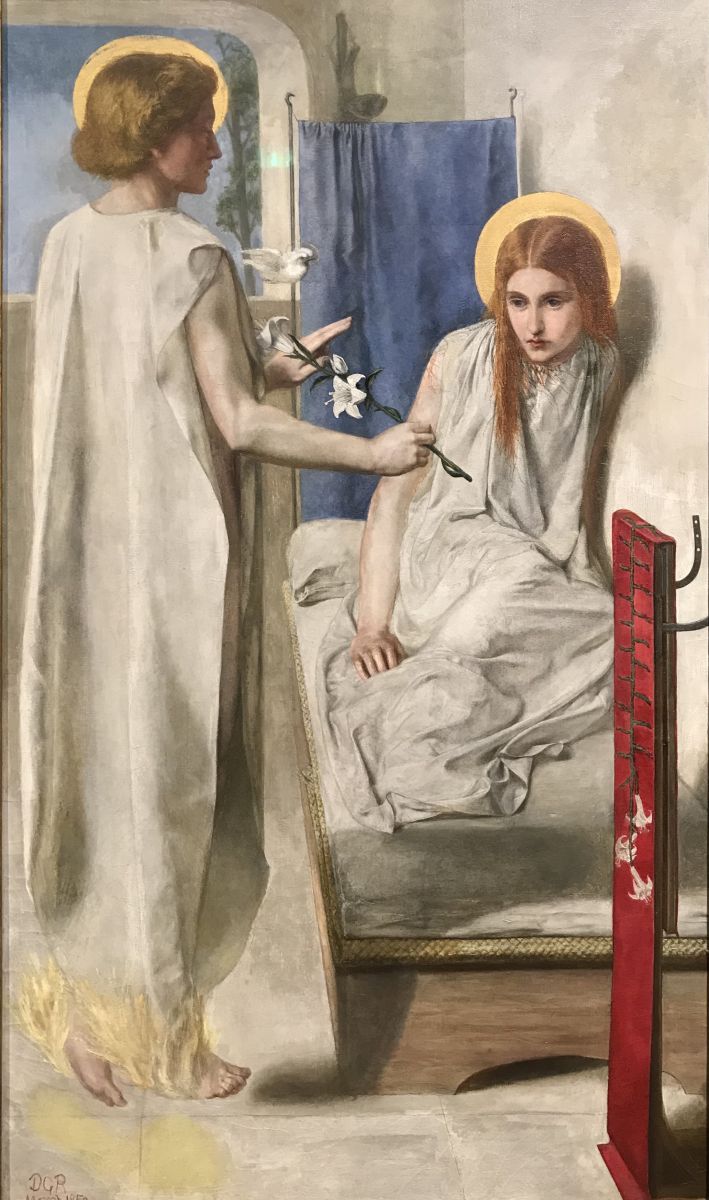Ecce Ancilla Domini Dante Gabrielle Rossetti 1849 Tate Britain
This painting of the Annunciation has always troubled me. The perspective is so tight, so steep, it creates a sense of extreme claustrophobia and deep tension. The line of the edge of the bed is almost vertical while Mary cowers in the corner, retreating as far as she can from the wingless angel. This is far from the treatment of the subject by such painters and Fra Angelico, Fra Filippo Lippi or Titian. Mary here is petrified and defenceless rather honoured and blessed.

Rossetti used his sister, Christina Rossetti, who eventually became one of England’s great poets and author of ‘In the Bleak Midwinter’, as his model. At the age of twelve she suffered from persistent bronchitis. At fourteen she had a nervous breakdown followed by bouts of depression. When she posed for this painting at 17, I can well imagine that anorexia could be added to the list. She could not be a more vulnerable Mary.
Her wide, dark eyes are glazed over. There is no spark of vitality in them as she stares at the lily being offered to her and avoids the gaze of the angel. Her hair, though neatly parted, straggles in fine red threads over her white gown and shoulder, as if sticking after a hot and sweaty night from which she has just been awakened.
The painting is dominated by a white palette; almost oppressively so. This, together with the lily which the angel is holding and the embroidered lilies, symbolise purity. Is her purity/virginity being over-emphasised? Here is a young, adolescent girl who really does not look ready for conception and childbirth!
The model for the angel was William, her elder brother. Instead of having the conventional wings, his feet hover on spiritual flames and, although naked beneath his robe, he makes a reassuring gesture with his left hand, above which hovers a small, haloed white dove.
There is a long and somewhat macabre history of gods seducing, raping or otherwise impregnating mortals. Zeus raped Europa disguised as a bull; he raped Leda when disguised as a swan as well as Callisto, Hera and Nemesis. In Irish mythology the great war hero Cuchulainn was the son of the Irish god Lugh and the mortal princess Deichtine. Members of the early Christian church will have been very familiar with such myths.
The Christian story of the Annunciation is very different, as if the ancient myths are being transposed into a new faith. There is no violence in the Christian version. No sense of rape or seduction, indeed sex does not form part of the narrative at all. And the offspring of the union is not a demi-god or war hero, but a full member of the Trinity, at one with His Father, destined to be passively executed.
Rossetti did not choose to call the painting The Annunciation, but rather ‘Ecce Ancilla Domine’ or ‘Behold the Handmaid of the Lord:’ the words of Mary in accepting her awesome role as mother of Jesus. My feeling is that Rossetti is making as great a contrast as he can between the enormity of the role and the cowering fragility of the girl that God has chosen. It is a pattern that is repeated throughout the New Testament: the most unlikely disciples are picked, the poorest are blessed; the last are to come first and the first to come last. Where Greek mythology deals with heroes and heroic acts on the battlefield, Christianity deals with anti-heroes and acts of self-sacrifice in modest and unassuming lives.
Maybe it is not such an uncomfortable painting after all.
https://www.tate.org.uk/art/artworks/rossetti-ecce-ancilla-domini-the-annunciation-n01210
